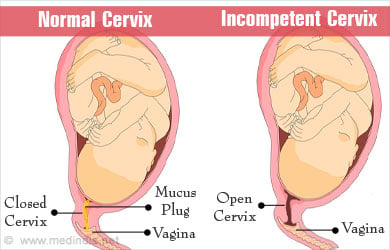- Lotgering FK. Clinical aspects of cervical insufficiency. BMC Pregnancy Childbirth. 2007; 7(Suppl 1): S17. doi: 10.1186/1471-2393-7-S1-S17
- Arora M. Recurrent Pregnancy Loss. 2nd edition
What is Incompetent Cervix?
The cervix is the lower tubular part of the uterus that occupies the upper part of the vagina. It is usually firm in consistency. It has a central opening called the cervical canal, the upper end of which is called the internal orifice, while the lower end is called the external orifice. In a normal delivery, the baby comes out through the cervix and the vagina.
Throughout pregnancy, the closed cervix does not allow the fetus to come out of the uterus. Several changes are noted in the cervix during pregnancy. There is increased blood flow to the cervix giving it a bluish color. The glands of the cervix secrete a mucus plug that blocks the opening of the cervix, and reduces the chances of infection.

Prior to delivery, the cervix becomes softer, shorter and its walls begin to thin out. During labor, the cervix begins dilating along with the contractions. A fully dilated cervix of 10 cm allows the vaginal delivery of the baby.
If dilatation of the cervix occurs well before the completion of 9 months, there could be a miscarriage. This condition is referred to as cervical insufficiency or cervical incompetence. The miscarriage due to cervical insufficiency commonly occurs in the second trimester or sometimes, the early third trimester.
What are the Causes of Incompetent Cervix?
In some cases, the exact cause of incompetent cervix is not known. Causes of cervical incompetence in pregnancy include the following:
- Abnormality in the cervix, which could occur in:
- Exposure to a drug called DES (diethylstilbestrol) during pregnancy, which can result in an abnormality in the cervix of the female baby. Besides the cervix, abnormalities in the uterus may also be present. This drug is currently banned during pregnancy.

- Conditions like Ehlers-Dandos syndrome, in which the collagen in the cervix can get affected.
- Previous surgery carried out on the cervix like:
- Medical termination of pregnancy: During this procedure, the cervix may be manually dilated, which could result in incompetence during future pregnancies.
- Conization biopsy: In this procedure, a biopsy is obtained from the cervix in the form of a cone to diagnose for cervical cancer. Thus, there is a loss of cervical tissue, which could result in incompetent cervix.
- Prior tears to the cervix
What are the Symptoms and Signs of Incompetent Cervix?
A person with an incompetent cervix during pregnancy usually experiences the following:
- Vaginal discharge due to infection of the exposed fetal membranes
- Repeated sudden miscarriages in the second or early third trimesters with minimal pain, and with no obvious cause. Miscarriages in the first trimester are not due to incompetent cervix.
- However, it is not necessary to wait for several miscarriages to take place before a diagnosis can be made. Adequate measures should be taken to diagnose and prevent further miscarriages even if one second trimester miscarriage occurs due to incompetent cervix.
How to Diagnose Incompetent Cervix?
It is usually uncommon to diagnose incompetent cervix before a miscarriage has taken place.
Diagnosis of incompetent cervix is through history obtained from the patient and a gynecological examination.

Diagnosis during pregnancy is done using ultrasound between 18 to 22 weeks of pregnancy. On ultrasound, the cervix may appear short. Also, funneling, may be present, that is, the upper end of the cervix may widen out.
How do you Treat Incompetent Cervix?
Once a woman has lost a baby due to incompetent cervix, there is a high chance that the episode will repeat with subsequent pregnancies. Therefore, precautions have to be taken well before such an incident occurs.
- The patient is advised bed rest.
- Medications to relax the uterus may be given.
- Serial assessments of the cervix are done during pregnancy either through examination or via ultrasound.
- Prophylactic cerclage is a procedure that is carried out to prevent further pregnancy losses due to incompetent cervix. In this procedure, a stitch is put around the cervix to give it mechanical strength and prevent dilatation. The procedure can be done either through the abdominal approach with a laparoscope, or through a transvaginal approach. The modified Shirodkar and McDonald techniques are two common techniques used in cerclage. The procedure is usually carried out in the early second trimester, between 12 and 16 weeks of pregnancy.
In some cases, if a woman shows signs of shortening of cervix during pregnancy and a prophylactic cerclage had not been done, an urgent cerclage can be done if necessary. An emergency cerclage is done if the fetal membranes are noted to be protruding from the cervix.
Once the stitch is in place, the woman is advised to avoid travel and also to avoid sexual intercourse for a week.
The stitch is removed once the pregnancy has completed 37 weeks or if labor pains begin. In case an abdominal cerclage was done, delivery is carried out through caesarian section.





